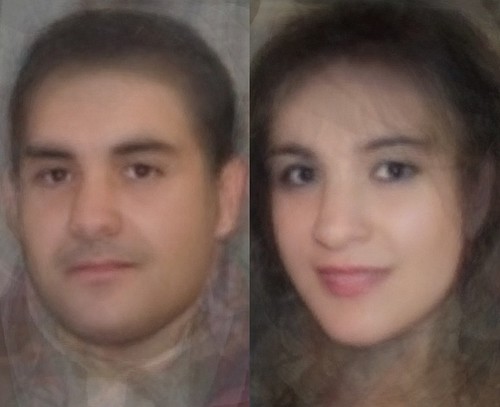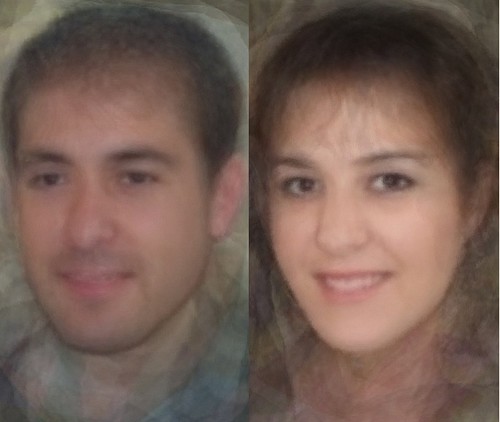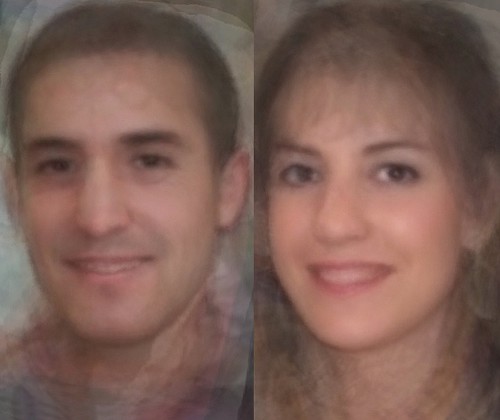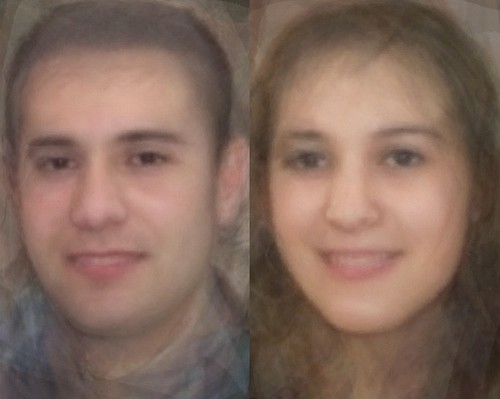7






















| Thumbs Up |
| Received: 3,356 Given: 7,733 |

Before: i don't say that this person is right, but I post his different analyzes because I find it interesting. This is not a troll thread.
Spain
Part 1:
Aracena : Andalusia (Spain)
Sample:
Brief anthropological analyzis :
- Brachy type : striking Andalusian features are a puffy nose and a well-defined mouth area ;
- Lepto type : pan-Iberian ;
Morphotypes :
Caravaca : Murcia (Spain)
A recent study (see Maju's summary here : Basque autosomal genetics) has shown that Murcians may have been less subject to Neolithic migrations than their immedate neighbours such as Andalusians or Valencians, a fact corroborated by archeology. Consequently, I've decided to deal with Murcia once more, this time making more localized samples, in order to check whether or not Murcians really appear more Northern-looking in a South Iberian context, phenotypically wise. I'll begin that "remake" of Murcia in the NE of the province, around Caravaca de la Cruz.
Sample :
Brief anthropological analysis :
- Type 1 : Intermediate complexion (from blonde to dark hair, grey/black eyes, rather pale skin on average, ...), leptomorphic, long face (particularly on males), long and convex nose rather parallel to the face, close-set eyes, pointy chin, large jaw
~ Dinaricized Atlanto-Mediterranean
I cannot possibly say whether or not these individuals are strikingly more Northern-looking than their neighbouring counterparts. This type is rather pan-Iberian even though these individuals' relative robustness rather places them within the North-West Iberian spectrum as opposed to the East-Iberian pole (the famous "horsy" features).
A square-boxed variant - transition with Type 2 - can be found as well. After browsing other samples, I find that such types are somehow rarer in Andalusia. These people remind me of Aragonese people from Teruel. I cannot say for sure but the nose seems to be always convex.
- Type 2 : Intermediate complexion (rather light hair, light eyes, ...), more or less brachymorphic, reduced and "puffy" features, square-box head, little and puffy nose, strong jaw, rather distanced and somehow chinky eyes
~ Alpino-Mediterranean
These people are somehow rather light though they could fit in Valencia or Andalusia albeit in rarer density. The puffy nose shape is rather commonly shared by all these people. I won't dare say these people corroborate the genetic results of the aforementioned study. We'll see later with more Murcian samples.
Final morphotypes :





















| Thumbs Up |
| Received: 3,356 Given: 7,733 |

Almería : Andalusia (Spain)
The area has been inhabited since the Upper Paleolithic with remnants of Mousterian activities in Cueva de Zájara. It was part of a greater Mediterrean arc noted for rupestrian art (see : "Arte rupestre del arco mediterráneo en la Península Ibérica").
The name "Almería" stems from Arabic المرية Al-Mariyya: "The Mirror". The city was built not far from the Iberian town known as Urci. The area was indeed submitted to Iberians before Roman occupation. It is now quite plausible that the Iberian language was a distant cousin to the Basque language (see this article in French from 2010 : "Iberian and Basque : researchs and comparisons" ; for instance one cannot help noticing that 'urki' in modern Basque simply means "birch").
Sample :
Brief anthropological analysis :
- Type 1 : Dark complexion, brachymorphic, broad face, round features, thick browridges , short broad nose, wide-spaced sloping eyes
~ Alpino-Mediterranean/Berid
A very classical Iberian type, it is abundantly found throughout the peninsula. Some minority individuals - more or less leptomorphic - do remind us of a very localized type that we identified in neighbouring Granada : high cheekbones, a broad jaw, a long upper lip, wide-set eyes, a "pseudo-mongoloid" eye shape (narrow eyelids), ...
- Type 2 : Intermediate complexion (rather pale skin, from chestnut to dark hair, ...) complexion, leptomorphic, robust features, long and high-rooted straight or rather wavy nose, close-set eyes, angular and somehow strong chin, large jaws
~ Atlanto-Mediterranean
On average, those generic Mediterranean people seem to show more affinities with coastal and northern Iberia (see Murcia) than with western Andalusia (see Huelva). Those affinities may be clearer with larger-faced variants. "Horsy" and very gracile phenotypes found in Portugal and western Andalusia are quite rare.
Final morphotypes :
Huelva : Andalusia (Spain)
The city may be the site of Tartessus; by the Phoenicians it was called Onoba. The Greeks kept the name and rendered it Ὄνοβα. It was in the hands of the Turdetani at the time of conquest by Rome, and before the conquest it issued silver coins with Iberian legends. The Tartessian language is an extinct pre-Roman language once spoken in southern Iberia and has recently been classified as a Celtic language.
Tartessos cultural area
Sample :
http://farm5.static.flickr.com/4067/...67db1eb3_b.jpg
Brief anthropological analysis :
- Type 1 : Dark complexion, brachymorphic, broad face, round features, thick browridges , short broad nose, wide-spaced sloping eyes
~ Alpinoid/Berid
This type was previously identified in western Spanish areas (Cáceres, Zamora) and Portugal. Because of the distribution of that type throughout the peninsula, it could be said to be Portuguese-looking : wide-spaced sloping eyes, a short broad nose and thick browridges really are quite specific (this type would fit a "Berid" definition) even though it's more obvious on males. Lighter individuals - green/grey eyes, chestnut hair - are to be found.
Variants - already identified in central Portugal - do exist (convex nose, broader features, ...) which can be transitional with Type 2.
- Type 2 : Dark complexion, leptomorphic, gracile general features, narrow "horsy" face, long and narrow nose, high cheekbones, a rather broad jaw, close-set eyes, rather narrow eyelids
~ Mediterranoid
This type was already identified in many Portuguese areas such as Alto Douro. Contrary to what we noticed in Portugal, sexual dimorphism is not obvious here (we'll see later that the situation is identical in Algarve). If anything, Huelva is part of a greater western Iberian variability. Lighter individuals are eventually found :
Final morphotypes :





















| Thumbs Up |
| Received: 3,356 Given: 7,733 |

Granada : Andalusia (Spain)
The area around Granada has been settled since prehistoric times : it's in Baza that the Lady of Baza was discovered on 22 July 1971. The city was founded by the Iberians in the 4th century B.C. and named Basti (probably occupied by the Bastetani).
The city of Granada's origins were as an Ibero-Celtic settlement, which made contact in turn with the Phoenicians, the Carthagenians, and the Ancient Greeks who had established colonies (Almuñécar was a Phoenician colony known as Sexi). By the 5th century BCE, the Greeks had established a colony which they named Elybirge (Greek: Ἐλιβύργη). Under the Ancient Roman rule of Hispania, in the early centuries CE, this city name had become "Illiberis" ("new town" in Iberian). Under Moorish occupation, it became the capital of the Caliphate of Cordoba under the name "Gárnata".
Sample :
Brief anthropological analysis :
- Type 1 : Dark complexion (dark hair but rather pale skin), more or less brachymorphic, reduced and "puffy" features, in some cases high-headed, rather short nose, low wide-set eyes
~ Alpino-Mediterranean
This type is the main type that one can encounter in inland Andalusia or Mancha. A much more localized subtype can be observed : high cheekbones, a broad jaw, a long upper lip, wide-set eyes, a "pseudo-mongoloid" eye shape (narrow eyelids), ... It reminds us of Berid types from Sardinia ((he speaks here of the type Alpinoid, present in Sardinia also, and not Dinarized Paleo-Sardinian type that one can find in Sardinia). As far as I know, this type is absent from the eastern Mediterranean coast (see Murcia). It's very prevailing amongst men.
- Type 2 : Dark complexion, leptomorphic, gracile general features, narrow "horsy" face, long and narrow nose, high cheekbones, a rather broad jaw, close-set eyes, rather narrow eyelids
~ Mediterranoid
A very classical Iberian phenotype that is found throughout the whole peninsula. There is somehow an "eastern" vibe about some male individuals (quite rare as most men fall in the first category as far as this sample from rural Granada is concerned : sexual dimorphism once more).
Final morphotypes :





















| Thumbs Up |
| Received: 3,356 Given: 7,733 |

Part 2
Huesca : Aragon (Spain)
Huesca's pre-Roman Iberian name was Bolskan. It was the capital of the Ilergetes, on the road from Tarraco (modern Tarragona) and Ilerda (modern Lleida) to Caesaraugusta (modern Zaragoza). The ethnic character of the area is rather dubious (Iberian or Basque ?) but it is a known fact a form of the Basque language might have been spoken up to the 1400s as proved by the infamous interdiction of 1349 : "quien faulare en basquenç pague por coto XXX sol...". Placenames undoubtedly show identified roots : Biscarrués, Gurrea, Loarre, ...
Sample :
Brief anthropological analysis :
- Type 1 : Intermediate complexion (from blonde to dark hair, grey/black eyes, rather pale skin on average, ...), leptomorphic, long face (particularly on males), long and convex nose rather parallel to the face, close-set eyes, pointy chin, large jaw
~ Dinaricized Atlanto-Mediterranean
As expected, these individuals seem to show obvious Basque-related features (a convex nose, a triangular face, high cheekbones, ...) while other individuals are more generic though still in the dinaromorphic spectrum which is the Pyrenean norm. More robust individuals and brachymorphic individuals are to be found and are rather stereotypically "North Aragonese"-looking.
Yet, much more interestingly perhaps, Huesca seems to exhibit Mediterranoid phenotypes which tend towards Catalan types and which are characterized by less impressive secondary features (rather little nose, brachymorphism, puffier features, ...).
Such types can eventually get more "extreme" thus showing very original features which I have yet to properly localize (full lips, puffy nose, strong eyebrows, ...) but that I somehow assimilate with Catalonia and neighbouring areas.
- Type 2 : Intermediate complexion (rather dark hair, light eyes, ...), brachymorphic, reduced and "puffy" features, square-box head, little and puffy nose, strong jaw, rather distanced and somehow chinky eyes
~ Alpinoid
Striking Alpinoid types, abundantly found South of the Ebro river, are rather rare and never archetypal.
Morphotypes finaux / Final morphotypes :





















| Thumbs Up |
| Received: 3,356 Given: 7,733 |

Tarazona : Aragon (Spain)
Around Turiaso (modern Tarazona), the Ebro river more or less constituted the border between the Vascones of proto-Basque background situated on the northern bank (in what is now the Navarrese Riberra and Cinco Villas) and the Belli affiliated to the Celtiberians on the southern bank controlling both the mines of Moncayo and the valley of the Ebro river. The sampled area - which more or less follows the southern bank of the Ebro river - was thus in Celtiberian land.
Celtiberian tribes in the vicinity of Saragossa
Sample :
Brief anthropological analysis :
- Type 1 : Intermediate complexion (from blonde to dark hair, black eyes, rather pale skin on average, ...), leptomorphic, long face (particularly on males), straight or convex nose, close-set eyes, pointy chin, large jaw
~ (Dinaricized) Atlanto-Mediterranean
This is a common Iberian type. These individuals don't show many signs of Basque influence (high cheekbones, triangle-shaped face, ...) contrary to their counterparts in Cinco Villas. We have clearly left "Vasconic" lands when crossing the Ebro river. The following "nose-less" variant confirms this assumption : we've entered "Iberian" lands.
- Type 2 : Intermediate complexion (rather dark hair, light eyes, ...), brachymorphic, reduced and "puffy" features, square-box head, little and puffy nose, strong jaw, rather distanced and somehow chinky eyes
~ Alpinoid
Another pan-Iberian type abundantly found in North Iberia. Some individuals charcaterized by a very strong jaw and a rather specific nose are quite typical from non-Pyrenean Aragon and clearly dominate as one goes southwards. Let's notice that contrary to some other Iberian areas, those "Alpinoid" individuals are rather light as far as complexion is concerned.
Final morphotypes :





















| Thumbs Up |
| Received: 3,356 Given: 7,733 |

Cinco Villas : Aragon (Spain)
Cinco Villas is one Aragonese comarca neighbouring Navarre in the West to which it had long belonged before the emergence of Aragon as a central Pyrenean power. Indeed, like its Navarrese neighbour, the area was populated by the Vascones, one of the many ancient Basque-speaking tribes of the area. This ancient Basque past still can be infered from the archaic placenames found in Cinco Villas : Ardisa, Isuerre, Ejea, Undués, Urriés, ... The local Aragonese language has been lost in most villages.
Sample :
Brief anthropological analysis :
- Type 1 : Intermediate complexion (from blonde to dark hair, grey/black eyes, rather pale skin on average, ...), leptomorphic, long face (particularly on males), long and convex nose rather parallel to the face, close-set eyes, pointy chin, large jaw
~ Dinaricized Atlanto-Mediterranean
These individuals seem to show obvious Basque-related features (a convex nose, a triangular face, high cheekbones, ...) while other individuals are more generic though still in the dinaromorphic spectrum as far as I can tell. Lighter and more robust individuals can be found : they are quite typical from Pyrenean variability and can be found from the Basque Country to Pyrenean Catalonia.
- Type 2 : Intermediate complexion, more or less leptomorphic, straight/convex nose that can get broad, large jaw, wide-set eyes
~ Dinaromorphic Alpino-Mediterranean
Those broader-faced types can be classically analyzed as lightly more brachymorphic variants of the first type - as I did in other samples for instance - though some specific features include a very large jaw, eyes that get distant, a rather large nose yet still convex, ... : they might constitute a fair approximation of an average Aragonese type.
Some clearly brachymorphic individuals (a broad and little nose, a bulbous forehead, ...) somehow diverge from the Pyrenean standard (even though this type is not absent from Basque lands for instance).
Morphotypes finaux / Final morphotypes :





















| Thumbs Up |
| Received: 3,356 Given: 7,733 |

Part 3
Oriente : Asturias (Spain)
Asturias has been occupied by humans since the Lower Paleolithic era, and during the Upper Paleolithic was characterized by cave paintings in the eastern part of the area. In the Mesolithic period, a native culture developed, that of the Asturiense, and later, with the introduction of the Bronze Age, megaliths and tumuli were constructed. In the Iron Age, the territory came under the cultural influence of the Celts; the local Celtic peoples, known as the Astures, were composed of tribes such as the Luggones, the Pesicos, and others, who populated the entire area with castros (fortified hill-towns).
Sample :
Brief anthropological analysis :
- Type 1 : Intermediate complexion (dark hair, ... but light eyes are frequent), leptomorphic, long face (particularly on males), straight or convex nose, rather close-set eyes, pointy chin, large jaw
~ (Dinaricized) Atlanto-Mediterranean
A pan-Iberian type, these individuals nevertheless show affinities with NW Iberia (Galicia, North Portugal, ...) when it comes to secondary features such as the eye region (rather "slanted" eyes on some individuals, big eyebrows, ...) or the general aspect of the face (strong "horsy" features commonly found in Portugal for instance).
- Type 2 : Intermediate complexion (from dark to chestnut hair, from black to green/blue eyes, ...), more or less brachymorphic, reduced and "puffy" features, in some cases high-headed, rather little nose (on males at least), strong jaw, close-set eyes
~ Alpino-Mediterranean
Such types have been abundantly described by classical anthropological literature : they dominate the whole Atlantic coast from Galicia to Western Cantabria (about Santander, phenotypes get more "Vascoid"). Let's notice a common secondary feature : eyes seem to be somehow "circled" in Asturias. More elongated variants can be found, yet still exihibiting those peculiar "puffy" features associated with the NW corner of Iberia.
Final morphotypes :





















| Thumbs Up |
| Received: 3,356 Given: 7,733 |

Luarca : Asturias (Spain)
Asturias has been occupied by humans since the Lower Paleolithic era, and during the Upper Paleolithic was characterized by cave paintings in the eastern part of the area. In the Mesolithic period, a native culture developed, that of the Asturiense, and later, with the introduction of the Bronze Age, megaliths and tumuli were constructed. In the Iron Age, the territory came under the cultural influence of the Celts; the local Celtic peoples, known as the Astures, were composed of tribes such as the Luggones, the Pesicos, and others, who populated the entire area with castros (fortified hill-towns).
Sample :
Brief anthropological analysis :
- Type 1 : Dark complexion (dark hair, ... but light eyes are frequent), leptomorphic, long face (particularly on males), straight or convex nose rather parallel to the face, rather close-set eyes, high cheekbones, pointy chin, large jaw
~ (Dinaricized) Atlanto-Mediterranean
A pan-Iberian type, these individuals nevertheless show affinities with NW Iberia (Galicia, Asturias, ...) when it comes to secondary features such as the eye region (rather "slanted" eyes on some individuals, big eyebrows, ...).
- Type 2 : Intermediate complexion (from dark to chestnut hair, from black to green/blue eyes, ...), more or less brachymorphic, reduced and "puffy" features, in some cases high-headed, rather little nose (on males at least), strong jaw, close-set eyes
~ Alpino-Mediterranean
Square-shaped variants are quite typical and dominant in this sample. On average, those individuals' complexion is lighter (green/blue eyes, chestnut hair, ...).
Final morphotypes :





















| Thumbs Up |
| Received: 3,356 Given: 7,733 |

Manacor : Balearic Islands (Spain)
Manacor is the capital of Llevant (Catalan for "East"), a comarca on the east side of the Balearic island of Majorca.
Sample :
Analyzis :
- Lepto type : long "horse-like" face, big convex nose, frequent light eyes, variable complexion.
To my eyes, this type is part of a East Pyrenean/Iberian variation quite dominant in Catalan-speaking areas as well as in neighbouring Aragon (where it gets transitional with West Pyrenean types).
I suppose those people could also be told to be Ligurian-looking as many North Italian types approach such people.
- Brachy type : rather puffy general features, little nose, narrow eyelids, distant eyes, variable complexion.
Those people remind me of mainstream Iberian types which are quite widespread in the peninsula. One has to notice that unsurprisingly enough, women fall in the brachy category.
Most of these people lack a decisive robust Catalan-looking character that brachy types in Catalonia possess (see my Catalan samples for an illustration) but rather remind me of people I identified in the Ebro valley (the "puffier" ones) : I dare state that the following people may illustrate a stronger Neolithic affinity in Balearic islands as proved by genetic data.
When using Dienekes' world 9 calculator, Balearic people's results are the following ones : one of the lowest scores for Atlantic/Baltic admixture (a proxy for aboriginal European) in Spain, a quite normal score for Southern admixture and one of the highest results for Caucasian admixture (a proxy for later Bronze Age migrations as far as I guess).
# Population Percent
1 Atlantic_Baltic 60.50
2 Southern 28.20
3 Caucasus_Gedrosia 9.70
Morphotypes :





















| Thumbs Up |
| Received: 3,356 Given: 7,733 |

Minorca : Balearic Islands (Spain)
The island is known for its collection of megalithic stone monuments : navetes, taules and talaiots, which speak of a very early prehistoric human activity. Some of the earliest culture on Minorca was influenced by other Mediterranean cultures, including the Minoans of ancient Crete. For example the use of inverted plastered timber columns at Knossos is thought to have influenced early peoples of Minorca in imitating this practice.
Sample
Brief anthropological analysis :
- Type 1 : Dark, leptomorphic, long and triangular head, long and straight or convex nose, close-set eyes, full eyebrows, pointy chin and large jaw
~ Dinaricized Atlanto-Mediterranean
This is the basic "horsy" Catalan type and is quite representative of the Eastern Pyrenees and the Mediterranean coast. Lighter individuals are found as well. Notice the mouth shape.
- Type 2 : Intermediate complexion, brachymorphic, large face, square-box head, little and straight puffy nose, rather distanced eyes, little eyelids on some individuals, large jaw
~ Alpino-Mediterranean
A classical pan-Iberian type, puffier individuals (large puffy nose, distanced eyes, ...) do belong to a classical Catalan coastal type as previously identified in proper Catalonia.
Final morphotypes :

There are currently 1 users browsing this thread. (0 members and 1 guests)
Bookmarks